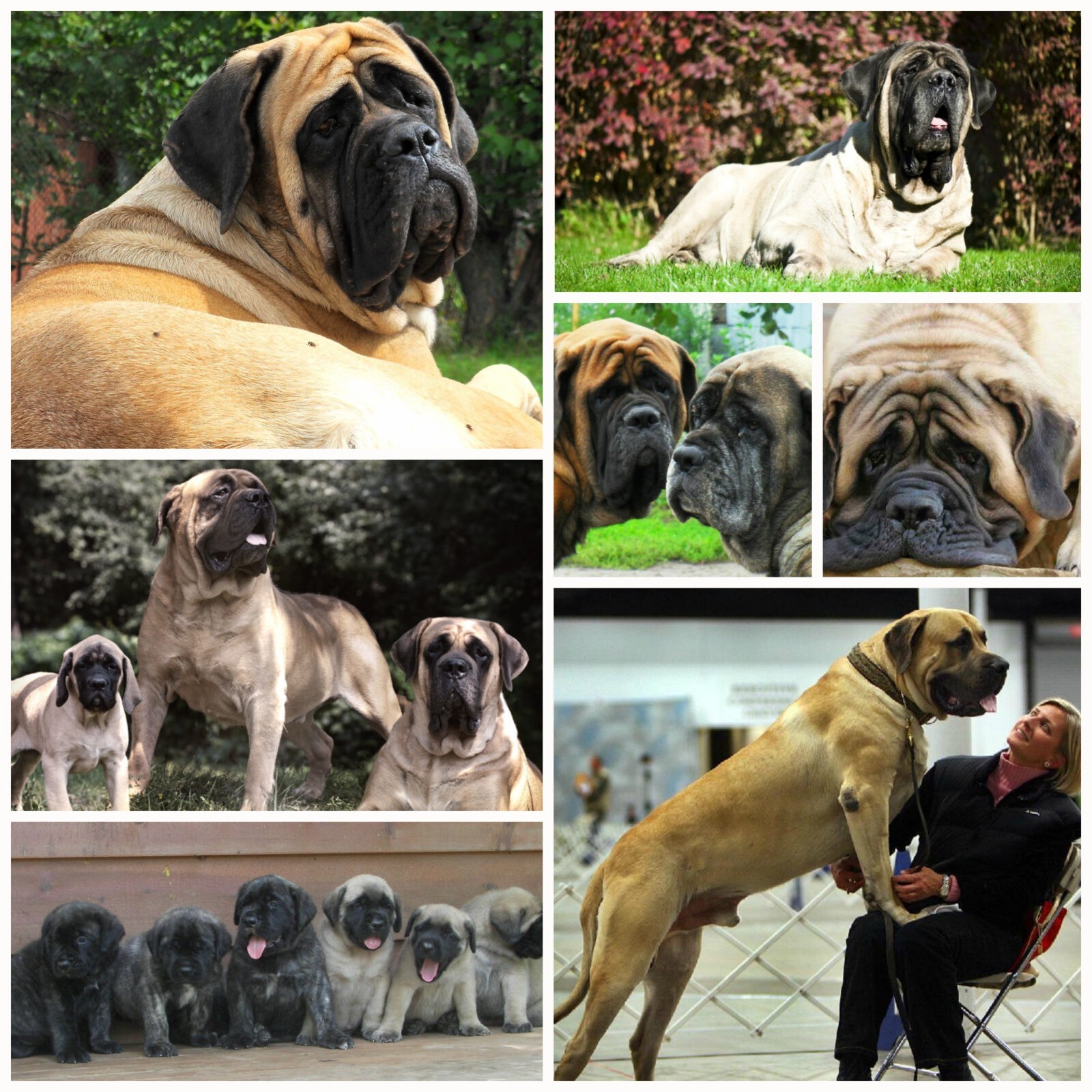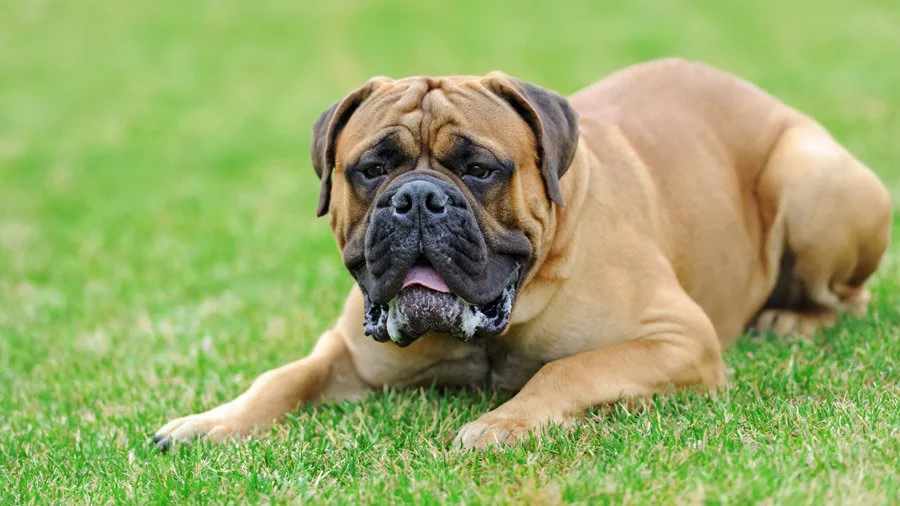Short description
These dogs can play the role of companions, watchmen and guards. Properly trained mastiffs are balanced, calm and very reliable friends of man. The birthplace of the English Mastiff is Great Britain, but not everything is so simple in the history of the breed. There is an opinion that already in the 5th-6th centuries BC there were mastiff-like dogs. Evidence of this are the numerous bas-reliefs found during the work of archaeologists. In ancient times, the ancestors of mastiffs were used to participate in numerous wars and in hunting. And today English mastiffs, despite such large dimensions, perfectly play the role of pets. There is no fuss in them, but if necessary, these giants can stand up not only for themselves, but also for the owner.
basic information
| Breed name: | english mastiff |
| Country of origin: | United Kingdom |
| The time of the birth of the breed: | 1883 |
| Type of: | Molossians |
| The weight: | 54 - 113 kg |
| Height (height at the withers): | 70 - 76 cm |
| Life Expectancy: | 7 – 12 years old |
|
ICF classification:
|
Group 2, Section 2.1, Number 264 |
| Puppies price: | 500 – 1500 $ |
| Most popular nicknames: | list of nicknames for the mastiff |
Evaluation of the characteristics of the English Mastiff breed
| Adaptability
(a definition meaning how easily a dog can adapt to changes in life) |
🐶🐶🐶🐶🐶 |
| Shedding level
(Level and frequency of hair loss in the animal) |
🐶🐶🐶 |
| Tenderness level
(The level and amount of tenderness and affection that the dog gives in return for attention to itself) |
🐶🐶🐶🐶🐶 |
| Exercise needs
(Dog's daytime activity level) |
🐶🐶🐶 |
| Social need
(The required number of contacts of the dog with other animals, as well as people) |
🐶🐶🐶 |
| Apartment content
(A factor that determines the level of noise and other inconveniences that a dog can deliver to owners in relation to the size of the apartment to the size of the dog) |
🐶🐶🐶 |
| Grooming
(The number of bathing, brushing, and the number of professional grooming sessions required for the dog) |
🐶🐶 |
| Friendliness in an unfamiliar environment
(Features of the behavior of a dog in a society with strangers or in an unfamiliar environment) |
🐶🐶🐶 |
| Tendency to bark
(Tendency to bark and its frequency and volume) |
🐶 |
| Health issues
(Potential health status of the dog) |
🐶🐶🐶🐶 |
| Territoriality
(The dog's tendency to protect his home, yard, or even his owner's car) |
🐶🐶🐶🐶🐶 |
| Friendliness to cats
(The tendency towards tolerance for cats and decreased manifestation of hunting instincts) |
🐶🐶🐶🐶🐶 |
| Intelligence
(The ability of the dog to think and solve emerging difficulties (not to be confused with learning!) |
🐶🐶🐶 |
| Education and training
(The level of difficulty in training the dog to perform certain actions) |
🐶🐶🐶 |
| Friendliness to children
(A factor that determines how friendly a dog is to children, whether he likes to play with them and tolerate some childish pranks) |
🐶🐶🐶🐶🐶 |
| Game activity
(The concept is determined by its very name, and, as a rule, is found in almost all dogs) |
🐶🐶 |
| Observation
(The ability of a dog to detect the presence of a stranger on its territory) |
🐶🐶🐶🐶🐶 |
| Friendliness to other dogs
(The tendency of the dog to find common language with his other relatives) |
🐶🐶🐶 |
Benefits of the English Mastiff
- Ideal family dog;
- Patient with children;
- Reliable defender;
- Smart, easy to train;
- Easy to care for.
Cons of the English Mastiff
- Expensive in content;
- He needs a lot of space;
- He is stubborn;
- Can be aggressive if provoked;
- Often drools and snores.
Appearance of English Mastiffs
English Mastiffs (also called Big Pugs or Old English Mastiffs) - dogs of powerful constitution with strong bones and a rather rough physique.
- Head English mastiffs are square in shape, large, proportional to the body. The muscles in the temples, crown and cheeks are developed, the superciliary arches and forehead are not very pronounced.
- Muzzle Mastiffs are rectangular, wide and fairly short.
- Ears set high, widely spaced, thin, relatively medium-sized head, hanging.
- Eyes small, oval, dark or light brown, set wide apart.
- nose wide (black pigmentation), nostrils large.
- Jaws square, strong teeth, scissor or level bite.
- Neck medium length or short, powerful and wide.
- Back English mastiffs of medium length, broad and muscular, convex in the lumbar region, sloping croup.
- Stomach selected.
- limbs with strong bones, strong, widely spaced, the muscles are well developed.
- Tail long, set high, sickle-shaped.
- Wool English mastiffs short, stiff, lying close to the body. The undercoat is quite dense, softer to the touch than the coat.
- Mastiff colors - apricot, brindle, fawn, silver, there is a mask and glasses in the form of dark areas of wool.
English mastiff photo:

History of the origin of the English mastiffs
English mastiffs are Molossians - dog-like large pickling dogs originally from Greece, Assyria and Egypt (the name "Molossians" comes from the people of the Molossians (or Molossians) - inhabitants of ancient Greece). The oldest ancestors of modern English mastiffs are considered tibetan mastiffs - ancient dogs from Central Asia, also common in many states of the Ancient World (Persia, Assyria, Babylon, etc.). Tibetan dogs, which performed working functions in their homeland, massively interbred with dogs from Asian countries. Puppies born from such unions were large, massive, hardy, often aggressive. Ancient mastiff-like dogs were used not only to help people in the household and protect housing. These big men fought along with ordinary soldiers in the campaigns of Alexander the Great in Persia (who became the ruler of Asia).
On the territory of Great Britain, mastiff-like dogs (different in appearance, purpose, type of character) were brought by the Celts around the 4th century BC. Numerous wars honed the character of strong, ferocious dogs. For example, the invasion of the Romans (I century BC), with whom the British mastiffs first fought and then served them faithfully, participating in gladiator fights and entertaining the public during the baiting of big game, made these dogs popular on the Apennine Peninsula. The Germanic tribes of the Saxons, who invaded Britain in the 4th century AD, brought their massive fighting dogs to the territory of the island state. Naturally, over time, the blood of mastiffs mixed with Saka dogs. Around the 20th century, Great Britain "sheltered" another four-legged - Alans imported from Europe.
More or less systematic breeding of mastiffs in Great Britain began only by the 15th century. But three centuries later, massive mastiffs ceased to be revered, presumably due to the prohibition of animal baiting in the British Isles. To preserve the breed, almost at the end of the 19th century, the blood of St. Bernards, Great Danes, Newfoundlands and other dogs began to flow to the surviving small mastiffs from Great Britain, then the world recognized the modern type of English mastiffs, officially recognized in 1883. But there were still difficult times ahead for the English mastiff strongmen. - World wars, when the number of these dogs was practically approaching zero. It was only in the 1950s that the breed ceased to be threatened, since from that moment on there were many clubs of lovers of such dogs, kennels around the world.
Personality of the English Mastiff
Maintenance and care
Living in such a large dog as the English Mastiff in a small city apartment is hard to imagine. Therefore, a free aviary is suitable as a dwelling for him, which the dog, if necessary, can leave to go around the yard, having warmed up a little. The apartment content is not welcome also from the fact that these dogs are not active by nature, they are happy to spend time in a light nap, as if thinking about something. So a passive lifestyle can lead to weight gain. English mastiffs prefer long, but leisurely exercise with the owner as a walk.
The coat of the English Mastiff should be combed several times a week. They cannot be considered excessively shedding, but if the removal of old hairs is neglected, the owner will face not only shreds of hairs on clothes, but also other problems (skin, parasitic diseases). These giants are bathed about 2-3 times a year in warm weather, and then dried thoroughly and combed well.
Obligatory care procedures include cleaning the ears (weekly with a cotton swab moistened with water or a special tool for hygiene of the auricles), eyes (daily or several times a week with a cotton pad moistened with water), teeth (with a toothbrush for dogs and toothpaste daily), nail clipping (every 2 weeks). In addition, the dog's face should be wiped after walking, as dirt accumulates in the folds of the skin. The same procedure should be done after eating.
As food, the English Mastiff can receive both natural food prepared by a caring owner, and ready-made food for large and giant breeds. In choosing a diet, a balanced diet is important. If the owner has enough time, then the Mastiff menu should contain enough protein (meat and offal), which is important for the immune system and proper muscle development. Also in the natural diet should be vegetables, cereals, dairy products (cottage cheese). Dry industrial food is extremely convenient for feeding - it does not deteriorate for a long time, it contains all the vitamins and minerals (and with natural feeding, vitamin preparations prescribed by a doctor will be required). But as a finished feed, preference is given to feed of the highest quality - not lower than the extra-premium level (or premium at worst), which are expensive, but useful. A puppy (up to 4 months) is fed up to 5 times a day, up to six months - 4 times a day, up to 8-10 months. - 3 times a day, and by a year and a half years the animal receives food twice a day. The bowls of the animal must be washed by the owner (after each meal). The dog should not need clean water.
Training and education
Health and disease of English mastiffs
Some interesting facts
- The average cost of a mastiff puppy in Russia is from 50 to 70 thousand rubles.
- The weight of the English Mastiff breed has been repeatedly recorded in the Guinness Book of Records. In 1989, a mastiff from the UK named Aikama Zorba became the champion among dogs in weight (155.5 kg). The height of the dog at the withers was 94 cm.
- Mastiffs are characterized by profuse salivation and snoring during sleep. As well as a cold mind, lack of anger towards people and animals.
Nurseries and breeders
We borrowed material from the wonderful site of our partners DOGCATFAN.COM about cats and dogs, the author dogcatfan

